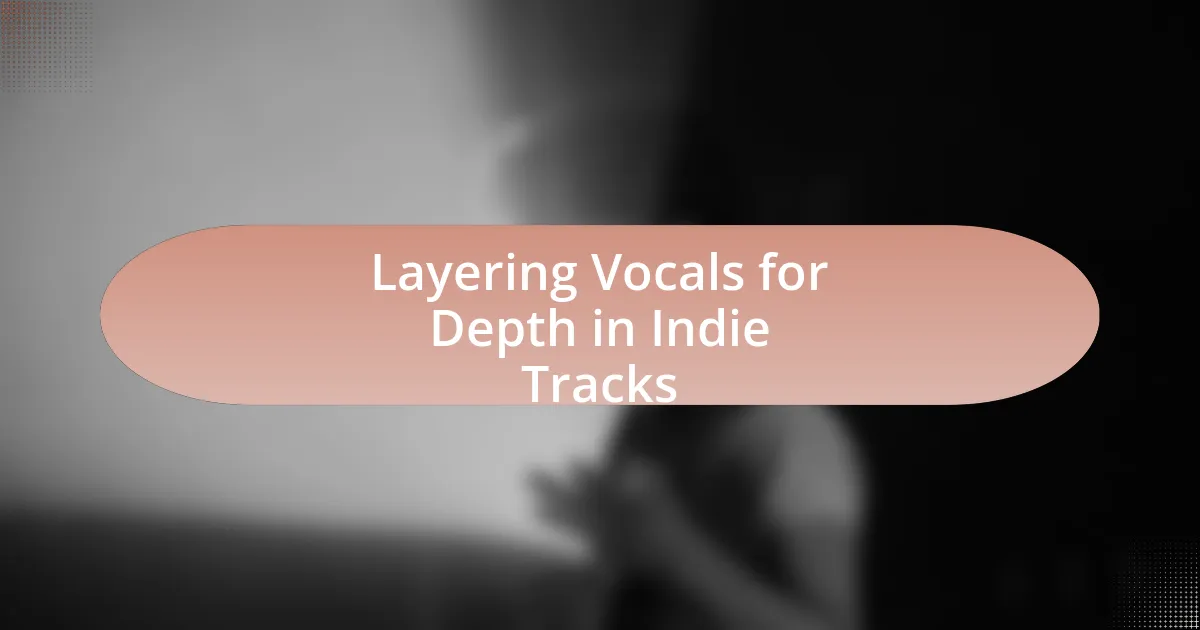Layering vocals for depth in indie tracks is a crucial technique that involves recording multiple vocal parts to create a richer and more textured sound. This article explores how vocal layering enhances the emotional impact and fullness of indie music, highlighting common techniques such as doubling, harmonization, and the use of spatial effects. It also discusses the importance of vocal layering in distinguishing indie tracks from other genres, reflecting the artistic identity of musicians. Additionally, best practices for recording layered vocals, essential tools and software, and common mistakes to avoid are examined, providing a comprehensive overview of effective vocal layering in music production.

What is Layering Vocals for Depth in Indie Tracks?
Layering vocals for depth in indie tracks involves recording multiple vocal parts and combining them to create a richer, more textured sound. This technique enhances the emotional impact and fullness of the music, allowing for harmonies, call-and-response patterns, or contrasting vocal styles that contribute to the overall atmosphere of the track. Studies in music production highlight that layered vocals can significantly increase perceived loudness and presence, making the vocals stand out in a mix. For example, artists like Bon Iver and Sufjan Stevens utilize vocal layering to evoke specific feelings and create immersive listening experiences, demonstrating the effectiveness of this technique in indie music.
How does vocal layering enhance the overall sound of indie tracks?
Vocal layering enhances the overall sound of indie tracks by adding depth, richness, and complexity to the vocal performance. This technique involves recording multiple vocal tracks that harmonize or complement each other, creating a fuller sound that engages listeners. For instance, studies show that layered vocals can evoke emotional responses, as they create a sense of intimacy and warmth, which is often sought after in indie music. Additionally, the use of vocal harmonies and textures can differentiate an indie track, making it more memorable and distinctive in a crowded music landscape.
What techniques are commonly used in vocal layering?
Common techniques used in vocal layering include doubling, harmonization, panning, and the use of effects such as reverb and delay. Doubling involves recording the same vocal part multiple times to create a fuller sound, while harmonization adds different vocal pitches to enrich the texture. Panning distributes the layered vocals across the stereo field, enhancing spatial depth. Effects like reverb and delay further contribute to the overall ambiance and depth of the vocal mix, making the vocals sound more immersive. These techniques are widely utilized in music production to achieve a polished and professional sound.
How does vocal layering contribute to the emotional impact of a song?
Vocal layering enhances the emotional impact of a song by creating a richer, more immersive listening experience. This technique allows multiple vocal tracks to blend together, adding depth and texture that can evoke stronger feelings in the listener. For instance, harmonies can convey a sense of longing or nostalgia, while contrasting vocal layers can illustrate conflict or tension within the song’s narrative. Research indicates that layered vocals can activate multiple areas of the brain associated with emotion, leading to a heightened emotional response. This is supported by studies showing that complex auditory stimuli, such as layered sounds, engage listeners more deeply than simpler compositions.
Why is vocal layering important in the indie music genre?
Vocal layering is important in the indie music genre because it enhances the emotional depth and richness of the sound. This technique allows artists to create a fuller, more textured auditory experience, which is essential for conveying the often introspective and nuanced themes prevalent in indie music. Studies have shown that layered vocals can evoke stronger emotional responses from listeners, making the music more engaging and memorable. For instance, artists like Bon Iver and Sufjan Stevens utilize vocal layering to build atmospheric soundscapes that resonate deeply with audiences, demonstrating its effectiveness in enhancing the overall impact of indie tracks.
What distinguishes indie tracks from other genres in terms of vocal arrangement?
Indie tracks are distinguished from other genres in terms of vocal arrangement by their emphasis on layered harmonies and unconventional vocal techniques. This genre often features multiple vocal tracks that create a rich, textured sound, allowing for emotional depth and complexity. For instance, artists like Bon Iver and Sufjan Stevens utilize intricate vocal harmonies and experimental layering, which contrasts with the more straightforward vocal arrangements typically found in mainstream pop or rock. This approach not only enhances the overall atmosphere of the music but also allows for greater artistic expression, making indie vocal arrangements unique and distinctive.
How does vocal layering reflect the artistic identity of indie musicians?
Vocal layering reflects the artistic identity of indie musicians by allowing them to create a unique sound that emphasizes their individuality and emotional expression. This technique enables artists to blend multiple vocal tracks, which can convey complex emotions and enhance the overall texture of their music. For instance, artists like Sufjan Stevens and Bon Iver utilize vocal layering to create rich, atmospheric soundscapes that resonate with listeners on a personal level. The use of varied vocal harmonies and effects not only showcases their creativity but also distinguishes their work from mainstream music, reinforcing their identity as independent artists who prioritize artistic freedom and innovation.

What are the key techniques for effective vocal layering?
The key techniques for effective vocal layering include using harmonies, varying vocal textures, and applying spatial effects. Harmonies enhance the richness of the sound by adding complementary pitches, which can create a fuller vocal presence. Varying vocal textures, such as mixing different vocal styles or timbres, contributes to a more dynamic and engaging listening experience. Applying spatial effects like reverb and delay helps to position the vocals within the mix, creating a sense of depth and space. These techniques are widely recognized in music production, as they allow for a more immersive and polished final product.
How can harmonies be effectively integrated into vocal layers?
Harmonies can be effectively integrated into vocal layers by carefully arranging vocal parts to complement the main melody, ensuring they enhance rather than overpower it. This involves selecting harmonies that are consonant with the melody, typically using intervals such as thirds and fifths, which create a pleasing sound. Additionally, varying the dynamics and timbre of the harmonies can add depth; for instance, using softer vocal layers for background harmonies while keeping the lead vocal prominent. Research indicates that well-structured harmonies can evoke emotional responses, as seen in studies on music perception, which highlight how harmonies influence listener engagement and emotional impact.
What role do intervals play in creating harmonies?
Intervals are fundamental in creating harmonies as they define the distance between pitches, influencing the overall sound and emotional impact of the music. In harmony, specific intervals, such as thirds and fifths, are commonly used to produce consonant sounds that blend well together, enhancing the richness of vocal layers in indie tracks. Research in music theory indicates that consonant intervals create a sense of stability and resolution, while dissonant intervals can evoke tension and movement, thus shaping the listener’s emotional experience. This interplay of intervals is crucial for layering vocals effectively, as it allows for a dynamic range of textures and depth in the final composition.
How can vocal harmonies enhance the listener’s experience?
Vocal harmonies enhance the listener’s experience by creating a richer and more immersive sound. When multiple vocal parts are layered, they add depth and complexity to the music, making it more engaging. Research indicates that harmonies can evoke emotional responses, as they often resonate with listeners on a psychological level, enhancing feelings of connection and enjoyment. For example, studies in music psychology show that harmonically rich music can lead to increased emotional arousal and satisfaction, making the listening experience more memorable.
What are the best practices for recording layered vocals?
The best practices for recording layered vocals include ensuring proper microphone placement, using consistent vocal techniques, and applying effective monitoring. Proper microphone placement, typically 6 to 12 inches from the vocalist, captures clarity and reduces unwanted noise. Consistent vocal techniques, such as maintaining the same pitch and energy level across layers, create a cohesive sound. Effective monitoring through headphones prevents bleed from other instruments and allows the vocalist to hear themselves accurately. These practices enhance the overall quality and depth of layered vocals in indie tracks.
How can microphone placement affect the quality of layered vocals?
Microphone placement significantly influences the quality of layered vocals by affecting the tonal balance, clarity, and spatial characteristics of the recording. Proper placement can enhance the richness of the vocal layers, allowing each voice to be distinct while contributing to a cohesive sound. For instance, positioning the microphone closer to the vocalist can capture more detail and warmth, while a distance placement may introduce a sense of space but can also lead to a loss of clarity. Studies have shown that variations in distance and angle can alter the frequency response, impacting how the layers blend together. Therefore, strategic microphone placement is essential for achieving a polished and professional sound in layered vocal recordings.
What recording techniques help achieve a polished sound?
To achieve a polished sound in recording, techniques such as proper microphone placement, using high-quality audio interfaces, and applying compression and EQ are essential. Proper microphone placement ensures optimal capture of the sound source, reducing unwanted noise and enhancing clarity. High-quality audio interfaces convert analog signals to digital with minimal distortion, preserving the integrity of the sound. Compression controls the dynamic range, making the audio more consistent, while EQ allows for tonal adjustments that enhance the overall mix. These techniques are widely recognized in professional audio production for their effectiveness in creating a polished final product.

What tools and software are essential for layering vocals?
Essential tools and software for layering vocals include digital audio workstations (DAWs) like Ableton Live, Pro Tools, and Logic Pro X, as well as plugins such as Melodyne for pitch correction and Waves Vocal Rider for automatic level adjustment. These tools enable precise control over vocal tracks, allowing for effective layering and enhancing the overall sound quality. DAWs provide the necessary environment for recording, editing, and mixing multiple vocal layers, while plugins offer specialized functions that improve vocal clarity and balance.
Which digital audio workstations (DAWs) are best for vocal layering?
The best digital audio workstations (DAWs) for vocal layering include Ableton Live, Logic Pro X, and Pro Tools. Ableton Live is favored for its intuitive interface and powerful audio manipulation capabilities, making it ideal for layering vocals in creative ways. Logic Pro X offers advanced features like Flex Time and Flex Pitch, which enhance vocal layering and editing. Pro Tools is renowned in professional studios for its robust editing tools and high-quality audio processing, making it a top choice for intricate vocal arrangements. These DAWs are widely recognized in the music production community for their effectiveness in achieving rich, layered vocal tracks.
What features should one look for in a DAW for vocal production?
A Digital Audio Workstation (DAW) for vocal production should include features such as multi-track recording, advanced editing capabilities, high-quality audio effects, and support for VST plugins. Multi-track recording allows for layering multiple vocal takes, which is essential for creating depth in indie tracks. Advanced editing capabilities, including pitch correction and time stretching, enable precise manipulation of vocal performances. High-quality audio effects, such as reverb and compression, enhance vocal clarity and presence. Support for VST plugins expands the range of available tools for vocal processing, allowing for customized sound design. These features collectively contribute to a more effective and creative vocal production process.
How do plugins enhance the vocal layering process?
Plugins enhance the vocal layering process by providing tools that improve sound quality, add effects, and facilitate precise control over vocal tracks. For instance, pitch correction plugins ensure that layered vocals are harmonically aligned, while reverb and delay plugins create spatial depth, making the vocals sound fuller and more immersive. Additionally, equalization plugins allow for frequency adjustments that help each vocal layer occupy its own sonic space, preventing muddiness. Studies show that using these plugins can significantly increase the perceived richness of vocal arrangements, leading to a more polished final mix.
What are common mistakes to avoid when layering vocals?
Common mistakes to avoid when layering vocals include neglecting pitch alignment, failing to manage phase issues, and overusing effects. Pitch alignment is crucial; if layers are not in tune, they can create dissonance rather than harmony. Phase issues arise when vocal tracks are not properly aligned in time, leading to a thin sound or cancellation of frequencies. Overusing effects, such as reverb or delay, can muddy the mix and detract from clarity. These mistakes can significantly impact the overall quality of the vocal arrangement in indie tracks.
How can over-layering negatively impact a track’s clarity?
Over-layering can negatively impact a track’s clarity by creating a muddled sound where individual elements become indistinguishable. When too many vocal layers are added without proper EQ and panning, frequencies can overlap excessively, leading to phase issues and a loss of definition. This phenomenon is supported by audio engineering principles, which state that excessive layering can result in a frequency buildup, particularly in the mid-range, where most vocals reside. Consequently, the track may sound congested, making it difficult for listeners to discern lyrics and melodic nuances.
What are the signs of poorly executed vocal layering?
Signs of poorly executed vocal layering include a lack of clarity, phase cancellation, and an unbalanced mix. When multiple vocal tracks are layered without proper attention, they can create muddiness, making it difficult to distinguish individual voices. Phase cancellation occurs when vocal tracks are out of sync, resulting in a hollow sound. Additionally, if the levels of the layered vocals are not balanced, some may overpower others, leading to an uneven listening experience. These issues can detract from the overall quality of the track, making it sound unprofessional.
What practical tips can improve vocal layering in indie tracks?
To improve vocal layering in indie tracks, utilize varied vocal textures and harmonies. Incorporating different vocal styles, such as soft whispers alongside powerful belting, creates a rich soundscape. Additionally, using panning techniques to position vocals across the stereo field enhances depth, allowing each layer to stand out. Employing effects like reverb and delay can further add dimension, making the vocals feel more immersive. Research indicates that tracks with diverse vocal layers can increase listener engagement, as evidenced by studies showing that complex arrangements often lead to higher streaming rates.


